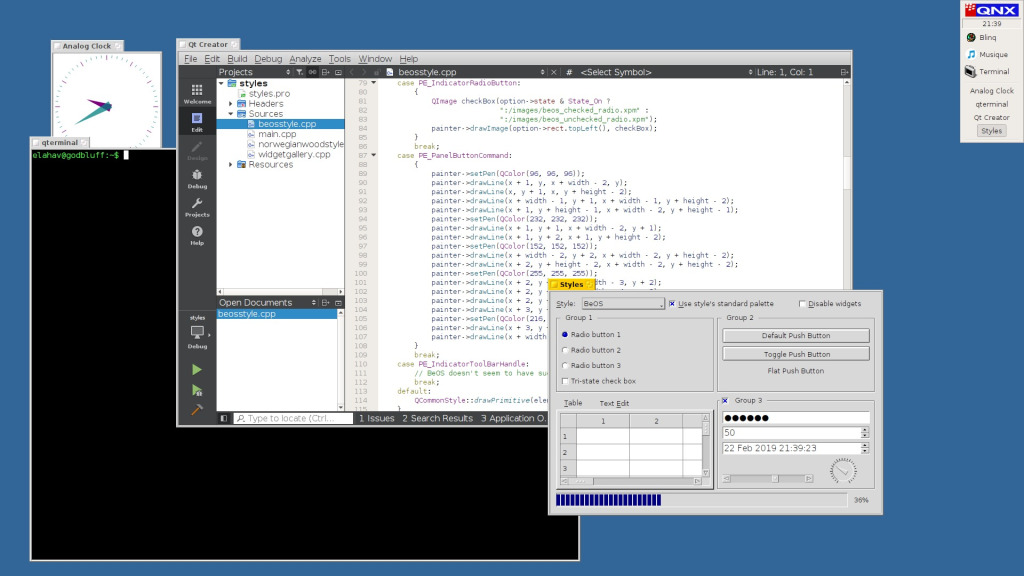I just found a blogpost-series about creating a desktop environment for QNX7:
And here is the end-result:

I just found a blogpost-series about creating a desktop environment for QNX7:
And here is the end-result:

It looks oddly familiar.
I remember about qnx in the past. I had a 1.2mb dikette and the complete system on it, but they are no interest for normal users only companys. So i come to beos :-).
Funny to see qnx in beos clothers
Had been looking for QNX last week to find it has gone commercial 
I had a 1.44mb diskette  . I had expressed interest (just out of curiosity) and they had sent me nice documentation, for free. Very interesting system. It was around 2000 I think. Very close to the time I learned about BeOS.
. I had expressed interest (just out of curiosity) and they had sent me nice documentation, for free. Very interesting system. It was around 2000 I think. Very close to the time I learned about BeOS.
Can’t remember how long it has been, but think I got some SDL games running on it back then 
It had always been commercial. It just had a free version to attract devs.
creo que se refieren al “superdrive” pero si no mal recuerdo era un diskette de doble densidad 2.8Mb no de 1.44.
Recuerdo que los “juegos” eran, mejor dicho, demos de OpenGL
QNX is a Blackberry property now…
There Blackberry 10 OS was QNX with QT/QML on top…
But it is still called as qnx, and it is still strong 
I Loved BB 10, hade 2 BB phones and also considering if a QNX powerd media in a new car is nice to have or a must 
Really miss physical keyboards on modern phones, I am one of those who just cannot get used to on-screen typing…
I am sorry that RIM went down leaving less choices to us users and I certainly and deeply hate HP for killing WebOS (at least as a phone choice). But at least I can look at my HP Pre3 right now and slide it out to remember the feeling…
I wonder if this QNX iteration is lighter weight than Haiku. Amiga Inc. considered QNX Neutrino microkernel for basing AmigaOS 4 on before they went with a non-SMP home grown ExecSG.
I use BB 10’s keybord… so nearly as if I hade there physical keybord 
I am trying to get the 30 day evaluation of the qnx hypervisor, it looks responsive and impressive (screenshots are in the same blog post from above) and there are other “lightweight hypervisor” projects but they really aren’t very responsive. I am glad that risc-v seems to be innovating on the virtualization front. I imagine the ideal computer architecture having a transmeta-style x86 simulator/co-processor built in - like Altivec, DEC FX32, etc… Running legacy x86 applications within ReactOS or WINE on a 2ghz sideboard wouldn’t add all that much to a system’s cost especially if it could be optional equipment.
QNX tried to create a more open dev community (openqnx.com is good) but it’s very corporate. It’s a shame because they used to have hobbyist licenses. I doubt very much the hobbyists and tinkerers are pirates or could afford qnx license fees otherwise. At least they have free educational licenses. I am applying for one right now.
There are some different qnx images (2.x, 4.x, and 6.x) on old-dos.ru, fsck.technology and archive.org.
It is badically the hobbyst license, as they dont force you to show student ID. Tell the sales rep you want to play with QNX and do not lie to them and they will issue you a license, first probably for a limited timeframe but they are are willing to extend it.
How can one get QNX OS as normal user?
Request an academic license, and if they ask, tell them you want a hobbyst license: Education Licenses - RTOS for Embedded Systems
Nice. Thank you. Do they have accelerated 3D stack?
You can check and research the feature-set of qnx at their website.
Keep in mind qnx has changed a lot since 6.x and it doesnt provides Photon (or any) desktop environment anymore, and as qnx targets mainly embedded usage therefore while it is not impossible, it is not trivial to get it self hosted. For more info read Elad’s blogpost series: Building a BlackBerry QNX 7 Desktop | Memory Barrier
Again: you can get a hobbyst/academic license, but if you dont have previous embedded experiences you will have a hard time figuring it out.